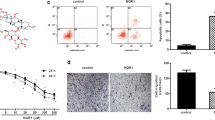Abstract
Medulloblastoma (MB), accounting for nearly 10% of all childhood brain tumors, are implicated with aberrant activation of the Hedgehog (Hh) signaling pathway. Saikosaponin B1 (SSB1) and Saikosaponin D (SSD), two bioactive constituents of Radix Bupleuri, are reported to have many biological activities including anticancer activities. In our work, we evaluated the inhibition of SSB1 and SSD on MB tumor growth in allograft mice and explored the underlying mechanisms. The associated biological activity was investigated in Shh Light II cells, an Hh-responsive fibroblast cell line, using the Dual-Glo® Luciferase Assay System. First, SSB1 (IC50, 241.8 nM) and SSD (IC50, 168.7 nM) inhibited GLI-luciferase activity in Shh Light II cells stimulated with ShhN CM, as well as Gli1 and Ptch1 mRNA expression. In addition, both compounds suppressed the Hh signaling activity provoked by smoothened agonist (SAG) or excessive Smoothened (SMO) expression. Meanwhile, SSB1 and SSD did not inhibit glioma-associated oncogene homolog (GLI) luciferase activity activated by abnormal expression of downstream molecules, suppressor of fuse (SUFU) knockdown or GLI2 overexpression. Consequently, SSB1 (30 mg/kg, ip) and SSD (10 mg/kg, ip) displayed excellent in vivo inhibitory activity in MB allografts, and the tumor growth inhibition ratios were approximately 50% and 70%, respectively. Our findings, thus, identify SSB1 and SSD significantly inhibit tumor growth in MB models by inhibiting the Hedgehog pathway through targeting SMO.
Graphical abstract






Similar content being viewed by others
References
Beachy PA, Karhadkar SS, Berman DM (2004) Tissue repair and stem cell renewal in carcinogenesis. Nature 432:324–331
Bale AE (2002) Hedgehog signaling and human disease. Annu Rev Genom Hum Genet 3:47–65
Ingham PW, McMahon AP (2001) Hedgehog signaling in animal development: paradigms and principles. Genes Dev 15:3059–3087
Robbins DJ, Fei DL, Riobo NA (2012) The Hedgehog signal transduction network. Sci Signal 5:6
Rimkus TK, Carpenter RL, Qasem S, Chan M, Lo HW (2016) Targeting the sonic Hedgehog signaling pathway: review of smoothened and GLI inhibitors. Cancers (Basel). https://doi.org/10.3390/cancers8020022
Norsworthy KJ, By K, Subramaniam S, Zhuang L, Del Valle PL, Przepiorka D, Pazdur R (2019) FDA approval summary: glasdegib for newly diagnosed acute myeloid leukemia. Clin Cancer Res 25:6021–6025
Northcott PA, Robinson GW, Kratz CP, Mabbott DJ, Pomeroy SL, Clifford SC, Pfister SM (2019) Medulloblastoma. Nat Rev Dis Primers 5:11
Taylor MD, Northcott PA, Korshunov A, Remke M, Cho YJ, Clifford SC, Pfister SM (2012) Molecular subgroups of medulloblastoma: the current consensus. Acta Neuropathol 123:465–472
Garcia-Lopez J, Kumar R, Smith KS, Northcott PA (2021) Deconstructing sonic Hedgehog medulloblastoma: molecular subtypes, drivers, and beyond. Trends Genet 37:235–250
Robinson GW, Orr BA, Wu G, Gururangan S, Lin T, Qaddoumi I, Gajjar A (2015) Vismodegib exerts targeted efficacy against recurrent sonic Hedgehog-subgroup medulloblastoma: results from phase II pediatric brain tumor consortium studies PBTC-025B and PBTC-032. J Clin Oncol 33:2646–2654
Ma H, Yokoyama S, Saiki I, Hayakawa Y (2017) Chemosensitizing effect of saikosaponin B on B16F10 melanoma cells. Nutr Cancer 69:505–511
Ren D, Luo J, Li Y, Zhang J, Yang J, Liu J, Xin H (2020) Saikosaponin B2 attenuates kidney fibrosis via inhibiting the Hedgehog pathway. Phytomedicine 67:153163
Maity T, Fuse N, Beachy PA (2005) Molecular mechanisms of Sonic Hedgehog mutant effects in holoprosencephaly. Proc Natl Acad Sci USA 102:17026–17031
Taipale J, Chen JK, Cooper MK, Wang B, Mann RK, Milenkovic L, Beachy PA (2000) Effects of oncogenic mutations in Smoothened and Patched can be reversed by cyclopamine. Nature 406:1005–1009
Yang J, Wang J, Liu Y, Zhang Y, Huang W, Zou Y, Tan W (2021) PGE2-JNK signaling axis non-canonically promotes Gli activation by protecting Gli2 from ubiquitin-proteasomal degradation. Cell Death Dis 12:707
Eichberger T, Sander V, Schnidar H, Regl G, Kasper M, Schmid C, Frischauf AM (2006) Overlapping and distinct transcriptional regulator properties of the GLI1 and GLI2 oncogenes. Genomics 87:616–632
Chen JK, Taipale J, Young KE, Maiti T, Beachy PA (2002) Small molecule modulation of Smoothened activity. Proc Natl Acad Sci USA 99:14071–14076
Bar EE, Chaudhry A, Farah MH, Eberhart CG (2007) Hedgehog signaling promotes medulloblastoma survival via Bc/II. Am J Pathol 170:347–355
Lu CN, Yuan ZG, Zhang XL, Yan R, Zhao YQ, Liao M, Chen JX (2012) Saikosaponin a and its epimer saikosaponin d exhibit anti-inflammatory activity by suppressing activation of NF-κB signaling pathway. Int Immunopharmacol 14:121–126
Waszak SM, Northcott PA, Buchhalter I, Robinson GW, Sutter C, Groebner S, Pfister SM (2018) Spectrum and prevalence of genetic predisposition in medulloblastoma: a retrospective genetic study and prospective validation in a clinical trial cohort. Lancet Oncol 19:785–798
Sasai K, Romer JT, Lee Y, Finkelstein D, Fuller C, McKinnon PJ, Curran T (2006) Shh pathway activity is down-regulated in cultured medulloblastoma cells: implications for preclinical studies. Cancer Res 66:4215–4222
Taipale J, Cooper MK, Maiti T, Beachy PA (2002) Patched acts catalytically to suppress the activity of Smoothened. Nature 418:892–897
Li X, Li X, Huang N, Liu R, Sun R (2018) A comprehensive review and perspectives on pharmacology and toxicology of saikosaponins. Phytomedicine 50:73–87
Acknowledgements
This work was supported by grants from the National Natural Science Foundation of China (No. 81573655), Opening Project of Zhejiang Provincial Preponderant and Characteristic Subject of Key University (Traditional Chinese Pharmacology), Zhejiang Chinese Medical University (No. ZYAOX2018002).
Author information
Authors and Affiliations
Corresponding authors
Ethics declarations
Conflict of interest
The authors declare that there are no conflicts of interest.
Additional information
Publisher's Note
Springer Nature remains neutral with regard to jurisdictional claims in published maps and institutional affiliations.
Rights and permissions
About this article
Cite this article
Luo, J., Wang, J., Yang, J. et al. Saikosaponin B1 and Saikosaponin D inhibit tumor growth in medulloblastoma allograft mice via inhibiting the Hedgehog signaling pathway. J Nat Med 76, 584–593 (2022). https://doi.org/10.1007/s11418-022-01603-8
Received:
Accepted:
Published:
Issue Date:
DOI: https://doi.org/10.1007/s11418-022-01603-8




